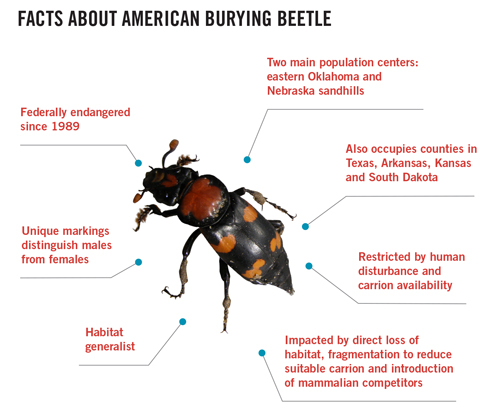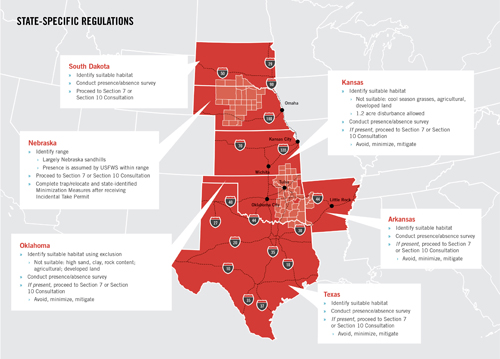Developing Wind Energy in Compliance with the Endangered Species Act: Guidelines for the American burying beetle
 Recently updated guidelines have dramatically changed conservation methods for wind power project proponents. These guidelines specifically address the American burying beetles (ABB; Nicrophorus americanus), which were listed as federally endangered under the Endangered Species Act in 1992 (see Figure 1).
Recently updated guidelines have dramatically changed conservation methods for wind power project proponents. These guidelines specifically address the American burying beetles (ABB; Nicrophorus americanus), which were listed as federally endangered under the Endangered Species Act in 1992 (see Figure 1).
As a result, wind power projects must now comply with Section 7 or Section 10 of the Endangered Species Act by conducting Biological Assessments or Habitat Conservation Plans to receive Incidental Take Permits from the US Fish and Wildlife Service (USFWS). The species habitat requirements and recognized conservation efforts to reduce potential impacts to ABB, such as habitat compensation and capture and relocation, vary from state to state.
Currently, there are two large ABB populations in the central United States: eastern Oklahoma and central Nebraska (see Figure 2). There are also several smaller populations in Arkansas, South Dakota, Kansas, and Rhode Island. The species is a habitat generalist when it comes to feeding, but will typically avoid areas with heavy human disturbance. Wind projects may impact ABB through a direct loss of habitat, habitat fragmentation reducing suitable food sources, and habitat fragmentation leading to the range expansion of mammalian competitors.
Compliance with the Endangered Species Act for wind power projects that are planned or considered within the range of the ABB is typically attained through three steps:
1. Avoid;
2. Minimize; and/or
3. Mitigate.
1. Avoid
With proper siting and environmental evaluations, a proposed wind power project should first identify potentially suitable habitat on the site of interest, so as to predict where ABB might occur. The USFWS Oklahoma Ecological Services Field Office defines areas of ABB non-suitable habitat as: soils containing high sand, clay, and rock content; developed lands; and agricultural areas.
In Oklahoma, projects on these types of habitats can proceed without impacts to ABB. However, this differs in Nebraska, as a large population of ABB occurs in the Nebraska Sandhills Ecoregion, where sandy soils provide for a suitable habitat.
A wind project can also elect to assume that ABB occur on a site of interest or conduct presence/absence surveys. Presence/absence surveys must be completed by a permitted biologist to determine if ABB are using the potential project site and, if so, at what density the species occur. Specific survey protocols vary by state, so careful attention to trap set-up and placement is important.
If ABB are confirmed on a wind project site, minimization and mitigation measures may be required. If presence/absence surveys do not capture ABB on the proposed site, the project can typically continue without further ABB concerns or impacts. Results of presence/absence surveys are valid for one year.
2. Minimize
 If ABB are confirmed on a potential wind project site, or if the project elects to assume ABB are present, the next steps are to minimize the possible impacts to the species. Steps to minimize impacts can include the development or positioning of siting roads and work areas, wind turbines and power lines, as well as any other onsite infrastructure, in areas of non-suitable habitat. Timing construction activities to occur during the winter months, when ABB are dormant, may also minimize potential impacts.
If ABB are confirmed on a potential wind project site, or if the project elects to assume ABB are present, the next steps are to minimize the possible impacts to the species. Steps to minimize impacts can include the development or positioning of siting roads and work areas, wind turbines and power lines, as well as any other onsite infrastructure, in areas of non-suitable habitat. Timing construction activities to occur during the winter months, when ABB are dormant, may also minimize potential impacts.
The USFWS Nebraska Ecological Services Field Office and Nebraska Game and Parks Commission may require a project to undergo capture and relocation measures. For such measures, ABB are captured onsite and released in suitable habitat at least two miles away. Nebraska is currently the only state that utilizes capture and relocation as a method to reduce potential impacts.
Because this procedure requires ABB to be trapped (a form of “take” under the Endangered Species Act) and removed from a site prior to development, capture and relocation measures can only be completed following completion of a Biological Assessment and Biological Opinion or a Habitat Conservation Plan and Incidental Take Permit from the USFWS. No states recognize the use of “bait away” as an effective minimization measure. Bait away stations create artificial means to attract a species away from potential development, but studies have found these measures largely unsuccessful in helping with conservation and expose ABB to greater predation risks at the bait away station.
3. Mitigate
Mitigation typically refers to offsite conservation easements, which are protected in perpetuity to provide suitable habitats for ABB. For example, Oklahoma has designated Conservation Priority Areas, where offsite mitigation is encouraged. Similar areas designated for conservation easements haven’t been developed in other states at this time.
Wind project proponents should determine the amount of potentially suitable habitats that cannot be avoided, determine a density of ABB within those habitats, and mitigate those areas impacted accordingly.
An Industry Conservation Plan developed for the oil and gas industry in Oklahoma has identified various mitigation ratios depending on the nature of the impact (permanent or temporary), and the location of the impact (within Conservation Priority Areas, previously established mitigation lands, or elsewhere). These mitigation ratios may be applicable to future wind projects, but must be developed through coordination with the USFWS and the appropriate state wildlife management agency.
As a project proceeds within the potential range of ABB, permitted biologists can assist wind power developers with surveys, Biological Assessments, or Habitat Conservation Plans to comply with the Endangered Species Act. As with any proposed project, it’s imperative to contact and involve the local USFWS Ecological Services Field Office and the respective state wildlife agency early in the planning process to avoid unnecessary project delays or expenses.
Ben Bainbridge is a biologist with POWER Engineers, Inc.
POWER Engineers, Inc.
www.powereng.com
Author: Ben Bainbridge
Volume: January/February 2015









.jpg?r=8642)


